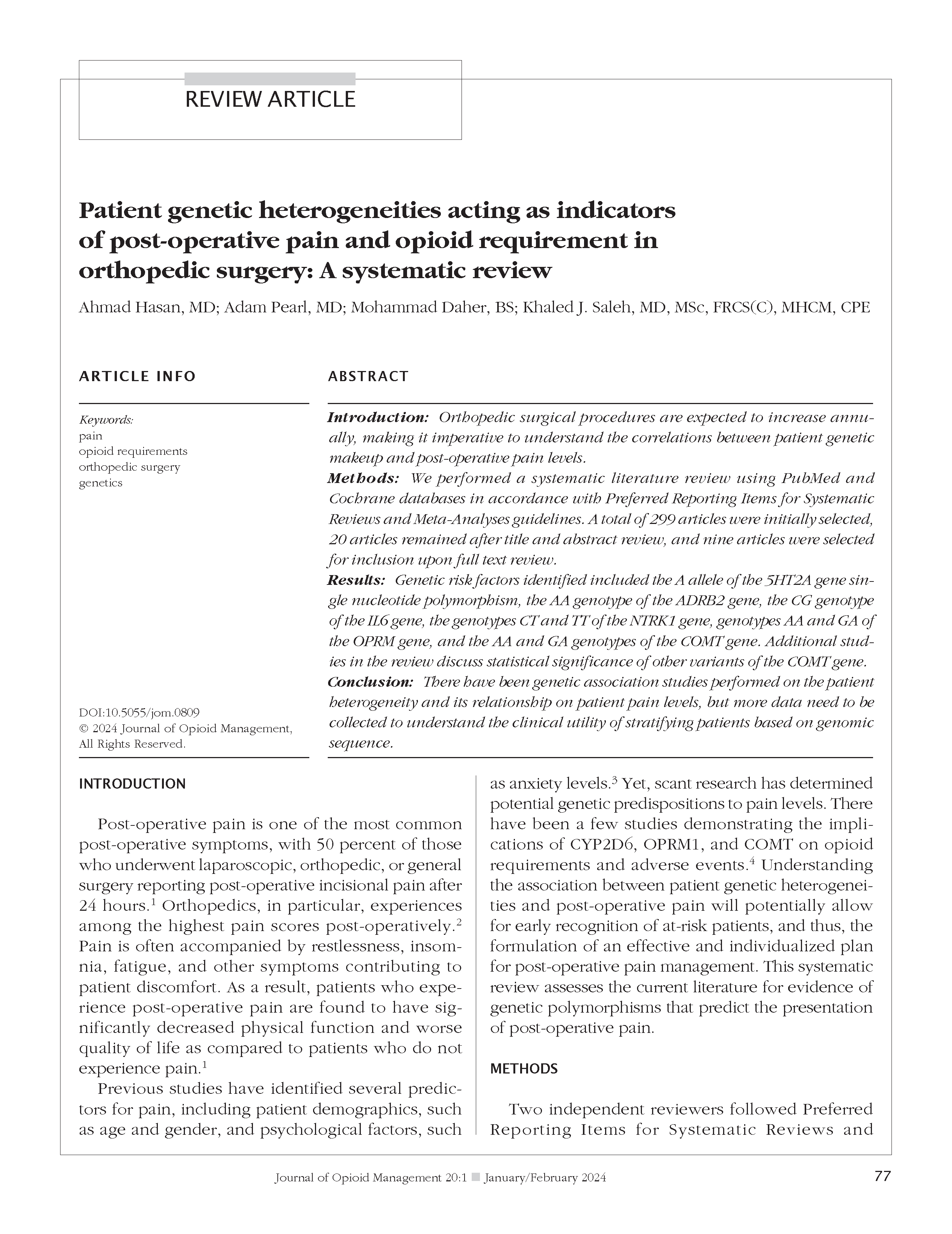Patient genetic heterogeneities acting as indicators of post-operative pain and opioid requirement in orthopedic surgery: A systematic review
DOI:
https://doi.org/10.5055/jom.0809Keywords:
pain, opioid requirements, orthopedic surgery, geneticsAbstract
Introduction: Orthopedic surgical procedures are expected to increase annually, making it imperative to understand the correlations between patient genetic makeup and post-operative pain levels.
Methods: We performed a systematic literature review using PubMed and Cochrane databases in accordance with Preferred Reporting Items for Systematic Reviews and Meta-Analyses guidelines. A total of 299 articles were initially selected, 20 articles remained after title and abstract review, and nine articles were selected for inclusion upon full text review.
Results: Genetic risk factors identified included the A allele of the 5HT2A gene single nucleotide polymorphism, the AA genotype of the ADRB2 gene, the CG genotype of the IL6 gene, the genotypes CT and TT of the NTRK1 gene, genotypes AA and GA of the OPRM gene, and the AA and GA genotypes of the COMT gene. Additional studies in the review discuss statistical significance of other variants of the COMT gene.
Conclusion: There have been genetic association studies performed on the patient heterogeneity and its relationship on patient pain levels, but more data need to be collected to understand the clinical utility of stratifying patients based on genomic sequence.
References
Chung F, Un V, Su J: Postoperative symptoms 24 hours after ambulatory anaesthesia. Can J Anaesth. 1996; 43(11): 1121-1127. DOI: https://doi.org/10.1007/BF03011838
Gerbershagen HJ, Aduckathil S, van Wijck AJ, et al.: Pain intensity on the first day after surgery: A prospective cohort study comparing 179 surgical procedures. Anesthesiology. 2013; 118(4): 934-944. DOI: 10.1097/ALN.0b013e31828866b3. DOI: https://doi.org/10.1097/ALN.0b013e31828866b3
Ip HY, Abrishami A, Peng PW, et al.: Predictors of postoperative pain and analgesic consumption: A qualitative systematic review. Anesthesiology. 2009; 111(3): 657-677. DOI: 10.1097/ALN.0b013e3181aae87a. DOI: https://doi.org/10.1097/ALN.0b013e3181aae87a
Crews KR, Monte AA, Huddart R, et al.: Clinical pharmacogenetics implementation consortium guideline for CYP2D6, OPRM1, and COMT genotypes and select opioid therapy. Clin Pharma Ther. 2021; 110(4): 888-896. DOI: 10.1002/cpt.2149. DOI: https://doi.org/10.1002/cpt.2149
Thomazeau J, Rouquette A, Martinez V, et al.: Acute pain factors predictive of post-operative pain and opioid requirement in multimodal analgesia following knee replacement. Eur J Pain. 2016; 20(5): 822-832. DOI: 10.1002/ejp.808. DOI: https://doi.org/10.1002/ejp.808
Białecka M, Jurewicz A, Cięszczyk P, et al.: Catechol-oxidemethyltransferase (COMT Rs4680:G>A) gene polymorphism does not affect analgesics' demand after elective hip replacement. Russ J Genet. 2016; 52(5): 539-542. DOI: 10.7868/s0016675816030048. DOI: https://doi.org/10.1134/S1022795416030042
Fernández-de-Las-Peñas C, Ambite-Quesada S, Fahandezh-Saddi Díaz H, et al.: The Val158Met polymorphism of the catechol-O-methyltransference gene is not associated with long-term treatment outcomes in carpal tunnel syndrome: A randomized clinical trial. PLoS One. 2018; 13(10): e0205516. DOI: 10.1371/journal.pone.0205516. DOI: https://doi.org/10.1371/journal.pone.0205516
Hegarty D, Shorten G: Multivariate prognostic modeling of persistent pain following lumbar discectomy. Pain Phys. 2012; 15(15): 421-434. DOI: https://doi.org/10.36076/ppj.2012/15/421
Mamie C, Rebsamen MC, Morris MA, et al.: First evidence of a polygenic susceptibility to pain in a pediatric cohort. Anesth Analg. 2013; 116(1): 170-177. DOI: 10.1213/ANE.0b013e31826f0637. DOI: https://doi.org/10.1213/ANE.0b013e31826f0637
Machoy-Mokrzyńska A, Starzyńska-Sadura Z, Dziedziejko V, et al.: Association of COMT gene variability with pain intensity in patients after total hip replacement. Scand J Clin Lab Investig. 2019; 79(3): 202-207. DOI: 10.1080/00365513.2019.1576920. DOI: https://doi.org/10.1080/00365513.2019.1576920
Lebe M, Hasenbring MI, Schmieder K, et al.: Association of serotonin-1A and -2A receptor promoter polymorphisms with depressive symptoms, functional recovery, and pain in patients 6 months after lumbar disc surgery. Pain. 2013; 154(3): 377-384. DOI: 10.1016/j.pain.2012.11.017. DOI: https://doi.org/10.1016/j.pain.2012.11.017
George SZ, Wu SS, Wallace MR, et al.: Biopsychosocial influence on shoulder pain: Influence of genetic and psychological combinations on twelve-month postoperative pain and disability outcomes: Postoperative outcomes and biopsychosocial influence. Arthritis Care Res. 2016; 68(11): 1671-1680. DOI: 10.1002/acr.22876. DOI: https://doi.org/10.1002/acr.22876
Warner SC, van Meurs JB, Schiphof D, et al.: Genome-wide association scan of neuropathic pain symptoms post total joint replacement highlights a variant in the protein-kinase C gene. Eur J Hum Genet. 2017; 25(4): 446-451. DOI: 10.1038/ejhg.2016.196. DOI: https://doi.org/10.1038/ejhg.2016.196

Published
How to Cite
Issue
Section
License
Copyright 2005-2025, Weston Medical Publishing, LLC and Journal of Opioid Management. All Rights Reserved.










